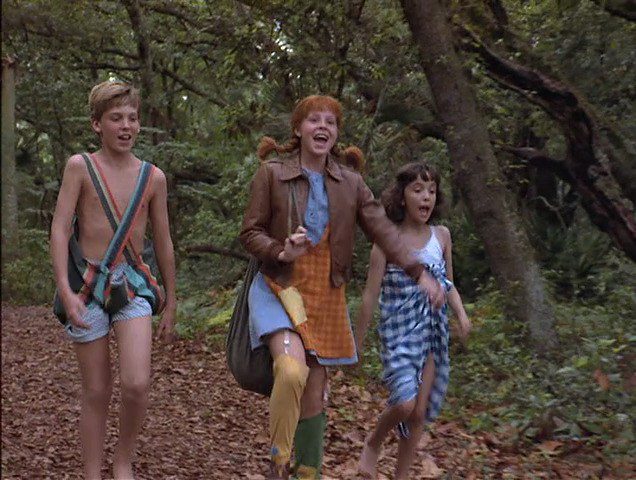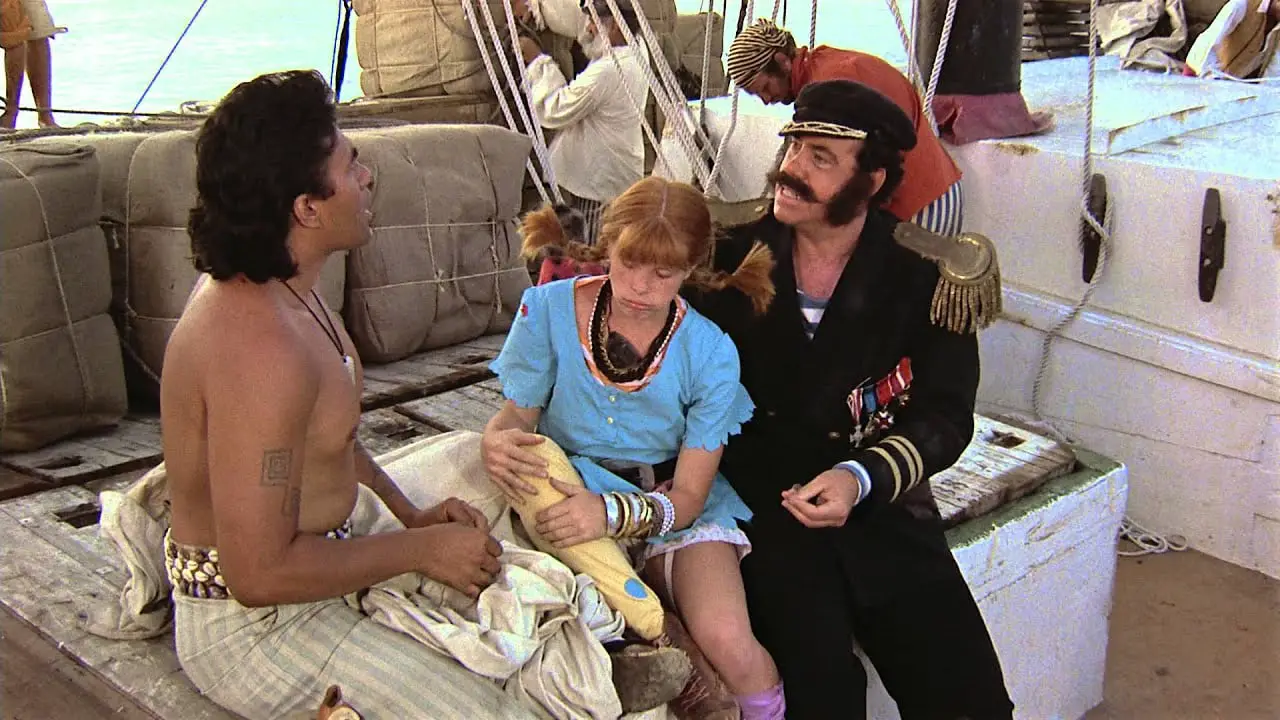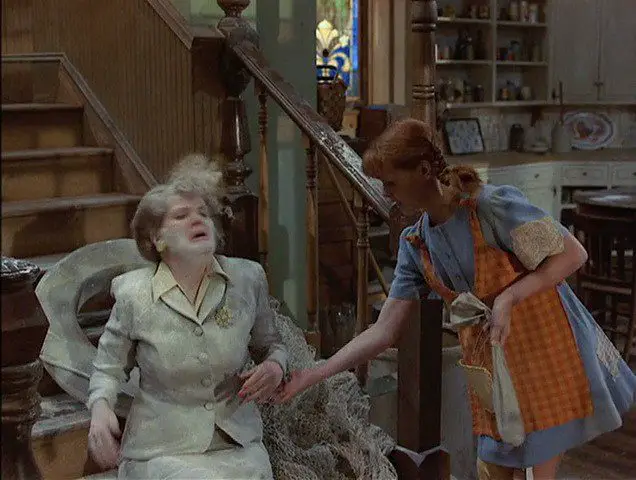The critics Christy Lemire and Alonso Duralde have a saying, “Was it great, or were you eight?” It was a question that weighed on my mind as I re-watched 1988’s The New Adventures of Pippi Longstocking, a movie I find myself revisiting once a decade or so.
I fondly remember seeing the movie as a child at the Nolan Fashion Square back home in Independence, Missouri. In those days, multiplexes weren’t as common as they are now. There were likely to be six theatres in a strip mall or an actual mall or across the street from the mall, or in the case of Blue Ridge, one in the Blue Ridge Mall and one across the street from the mall. It was there one summer afternoon when my mother dropped me off at the AMC while she went to clean a nearby house — television and AMC theatres did a lot of the heavy lifting as babysitters growing up — that I first saw Ken Annakin’s The New Adventures of Pippi Longstocking and formed one of my earliest childhood crushes on Pippi (Tami Erin).

So, the question remains, is The New Adventures of Pippi Longstocking good, or is it merely waves of nostalgia washing over me as I revisit this somewhat beloved Disney children’s box office dud? The answer, I’m afraid, will not satisfy most, as it’s a little from column A and a little from column B. It’s not great, but it has an insistent earnestness and an endearing commitment to magical realism that makes up for some of its flaws.
The biggest flaw is Annakin’s adaptation of Astrid Lindgren’s beloved books. Annakin had begged Lindstrom for the rights, arguing that children’s television was so full of violence that they needed to show the simple heroics of kindness. Speaking as a child of the 80s, he’s not entirely wrong. The problem is that Annakin’s tone is more at home in a 1950s slapstick comedy than an 80s adaptation of a series of Swedish children’s books. It’s small-town America by way of Disney’s Pollyanna.
Characters slip and fall; chaos often erupts in a scene but feels more calculated than natural, with the children carrying this off better than the adults. The shady realtor Mr. Blackheart (George DiCenzo) and his two toadies are stock villain characters ripped from other Disney movies, bumbling, hand wringing, dastardly, and feel like they were flung from a different film.
In addition, there’s no real story to The New Adventures of Pippi Longstocking. Instead, Annakin sews together several of Lindstrom’s books. Far from hurting the movie, this gives the film an odd feeling of an independent arthouse. In more experienced hands, the lack of narrative propulsion could have led to a startling sense of voyeurism, as if we are peeping in on these characters. In one instance, Roland Smith uses a handheld camera as he follows Mrs. Settigren (Dianne Hull) as she puts her two kids, Tommy (David Seaman) and Annika (Cory Crow), to bed.
Much like Pippi, Annakin feels adrift and unsure of where he should go. But in a way, it’s because of this that the stuff that does work is so effective. Erin’s Pippi is a shock to the small town’s system. Forthright and independent, she is brimming with agency and an unrepentant teller of tall tales. The sense of loneliness comes from a genuine desire to be part of a community, but not if it means she must stop being Pippi.

In many ways, Pippi can be read as Queer youth character — or, at the very least, on the queer spectrum. She challenges traditional gender roles and seems unbothered by the rules society seems bent on constraining her with. Yes, she wears a dress, but it’s a baggy dress with patches that she wears over fluffy pantaloons, almost as if she’s mocking traditional feminine wear while indulging in comfort.
A stronger film may have resisted the obvious Dinsey mandates shoved into the film. After a whole movie of watching Pippi run roughshod over the conservative town’s mores, her father Efraim, played to boisterous perfection by that staple of Robert Altman movies John Shuck, tells her, “In my heart I know a child needs to lead an orderly life.” A line laughably at odds with the agent of chaos that is Pippilotta Longstocking.
Annakin shows how well-meaning adults can smother a child’s imagination rather than bother it. Tommy and Anna’s father, Mr. Settigren, played by Adam Sander’s favorite director for hire, Dennis Dugan, is legitimately concerned for Pippi’s welfare, but he’s also a tight-ass who is genuinely annoyed at how she flagrantly flaunts the rules. The same goes for the sniveling Miss Bannister, the fantastic Eileen Brennan, who could play this character in her sleep as the head of the Children’s home who thinks Pippi is too independent.
Everyone is so worried about Pippi’s welfare that no one notices that Pippi is doing just fine. She needs someone to listen to her, not tell her what to do. But Annakin, despite his love of children, doesn’t seem to put much faith in them. These complicated ideas are often ignored, dropped, or flattened into meaningless. Pippi’s saved the children from the burning orphanage so she could live alone!
The other problem is that The New Adventures of Pippi Longstocking is a musical. While I admit as a child, I found some of the songs catchy, as an adult, I’m a little dumfounded at the laziness of the songs. The theme song, however, is still a banger, forever and ever.

Yet, despite all of this, the charm of The New Adventures of Pippi Longstocking is all the little things. It’s in Erin as Pippi herself, strutting about with joyous confidence, getting into scrapes and adventures, and speaking her mind with a kind of jolly confidence we rarely see little girls get to play onscreen. She can lift her talking horse, Alfonso (voiced by Frank Welker, aka Optimus Prime), fly, and walk on walls; she does it all with a joie de vivre most superheroes lack.
Erin’s Pippi is larger than life, and she sometimes makes the film she’s starring in feel a little too small as if it’s not entirely up to the task of being about her. But her energy and charm carry the film through its flat spots. In addition, she can bring a sort of infectious naivete as she breathlessly tells tales about cannibals and exotic lands that, while problematic, show how children treat the world around them with a kind of wide-eyed fascination.
The New Adventures of Pippi Longstocking is not a good movie for grown-ups, sad to say. It is a movie made for kids with a certain bewitching liveliness that speaks to children and, dare I say, the spark of curiosity and sense of play we keep inside as we grow up. The film is not without flaws, but it is also not without heart.
Images courtesy of Columbia Pictures
Have strong thoughts about this piece you need to share? Or maybe there’s something else on your mind you’re wanting to talk about with fellow Fandomentals? Head on over to our Community server to join in the conversation!

